This is Naked Capitalism fundraising week. 838 donors have already invested in our efforts to combat corruption and predatory conduct, particularly in the financial realm. Please join us and participate via our donation page, which shows how to give via check, credit card, debit card, or PayPal. Read about why we’re doing this fundraiser, what we’ve accomplished in the last year,, and our current goal, karōshi prevention.
Yves here. I’m not an aviation person, but a colleague who knows the industry thought Russia would not have too much difficulty making commercial aircraft since it makes military planes. The reason for turning to the likes of Boeing and Airbus is their planes have much better noise control and were cheaper. So Aeoflot customers won’t have as nice a ride until Russian makers get at least adequate at engineering in consumer level comfort.
There is also the non-trivial issue of how long it takes Russian aviation players to add capacity. But my understanding (and readers are free to correct me) is this always was an easier import substitution path than for cars and particularly car parts. But I’d welcome comments on this plan.
By John Helmer who has been the longest continuously serving foreign correspondent in Russia, and the only western journalist to have directed his own bureau independent of single national or commercial ties. Helmer has also been a professor of political science, and advisor to government heads in Greece, the United States, and Asia. Originally published at Dances with Bears
It was the American humourist Mark Twain who didn’t die in 1897 when it was reported that he had. Twain had thirteen more lively years to go.
The death of the Russian aerospace and aviation industry in the present war is proving to be an even greater exaggeration – and the life to come will be much longer. From the Russian point of view, the death which the sanctions have inflicted is that of the US, European and British offensive against the Soviet-era industry which President Boris Yeltsin (lead image, left) and his advisers encouraged from 1991.
Since 2014, when the sanctions war began, the question of what Moscow would do when the supply of original aircraft components was first threatened, then prohibited, has been answered. The answer began at the Federal Aviation Administration (FAA) in 1947 when the first Supplemental Type Certificate (STC) or Parts Manufacturing Approval (PMA) was issued by Washington officials for aircraft parts or components meeting the airworthiness standards but manufactured by sources which were not the original suppliers.
China has been quicker to implement this practice; Chinese state and commercial enterprises have been producing PMA components for Boeing and Airbus aircraft in the Chinese airline fleets for many years. The Russian Transport Ministry has followed suit; in its certification process and airworthiness regulations it has used the abbreviation RMA, Cyrillic for PMA. This process has been accelerating as the sanctions war has escalated.
So has the Russian process of replacing foreign imports entirely.
To understand what has already been done and what the Russians propose to do, here is what Vzglyad (“Viewpoint”), the leading Moscow source for security strategy and tactics, is reporting from Olga Samofalova. The text of her report has been translated and reproduced here without editing; captioned illustrations, videoclips and references have been added. Click to read the original in Russian.
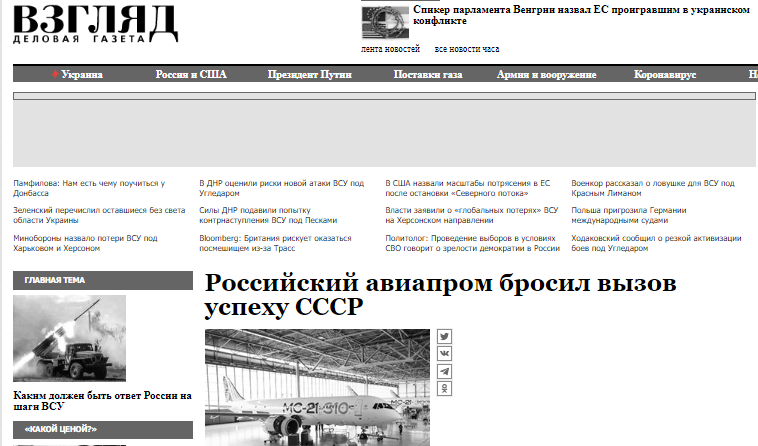
Source: https://vz.ru/
“Russian airlines are massively switching from foreign aircraft to domestic aircraft
September 8, 2022
By Olga Samofalova.
Russia intends to completely rebuild the country’s air transportation. And the first important step on this path is to transfer Russian airlines from foreign planes to exclusively domestic ones. Western sanctions have pushed our carriers to form the largest package of orders for domestic trunkline aircraft in modern history. Is the domestic industry ready for such a challenge?
Russian civil aviation is waiting for ‘systemic rearmament’ and the transition to Russian-made aircraft, Russian President Vladimir Putin said on Wednesday, speaking at the Eastern Economic Forum. According to the President, the country’s airlines have formed the largest package of orders in modern history, for about 500 mainline aircraft of domestic production.
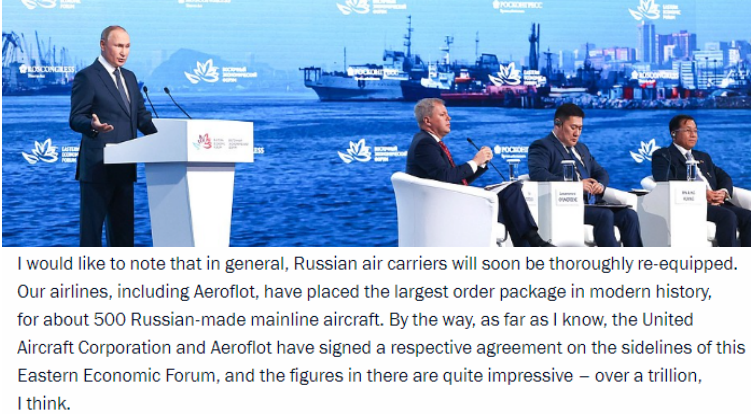
Source: http://en.kremlin.ru/
The interest in domestic aircraft is more than understandable and logical. Firstly, Russia has been creating its own civil aircraft from scratch for two decades, and finally we have not just the SSJ-100 – the first Russian aircraft since the USSR, but also an aircraft in the most popular class in the world – the MC-21 in an import–substitute version with a domestic engine.
The West’s sanctions strike against Russian airlines, which has seriously limited the use of Boeing and Airbus, spurred the acceleration of the transformation of domestic aviation. This is not only about the fact that airlines will now strive to switch to modern domestic technology as quickly as possible, but about the aviation industry which will have to grow to the production volumes that prevailed in the Soviet years – this is something contemporary Russia has forgotten about. Transformation in the industry means the emergence of new jobs – both in airlines and in aircraft factories.
The main order for the 500 domestic aircraft the President announced falls, of course, on Aeroflot. The Group has contracted 323 aircraft. These are 210 Irkut MC-21, 72 Sukhoi Superjet-100 and 40 Tupolvev Tu-214.
THE IRKUT MC-21
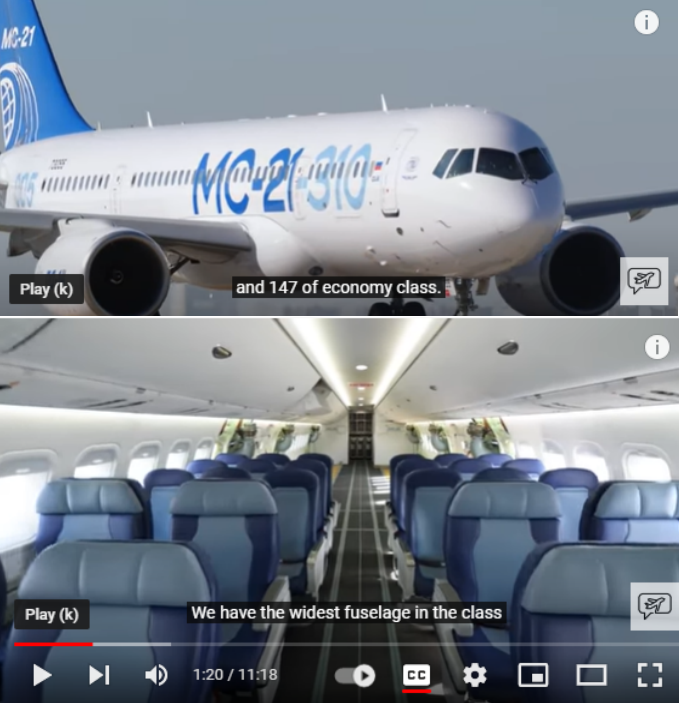
Source: https://www.youtube.com/
MS-21 in Russian, MC-21 in English, stands for Mainline Aircraft of the 21st Century. It was originally developed by the Irkut Corporation and the Yakovlev Design Bureau with the initial designation, YAK-242; first prototype flight was in 2017. Total projected budget for the project to 2025 is estimated at Rb437 billion. The Pratt & Whitney engine was replaced from 2020. The substitution of Russian avionics should be completed by the end of this year. They replace US and European components from Thales, Honeywell and Rockwell Collins. Altogether, it is planned to replace 54 foreign-made units and elements, including the auxiliary power plant, a stabilizer rearrangement mechanism, fuel system, hydraulic hoses, tyres, rescue emergency ladders and rafts, pilot seats, and interior elements of the passenger cabin. Domestic composite materials for the aircraft, include UMT 49S, UMT 42S and UMT 290 carbon fibres based on a domestic PAN-precursor manufactured by UMATEX (part of Rosatom). In addition, it is planned to use a binder tape of the ACM BE-C180UD brand produced by Prepreg-SCM, a company of RUSNANO; and a Robolen 200 tape produced by UNIMTEK. Domestic materials will be used in the design of wing consoles, elevators and rudders, and aircraft mechanisation units. The supplier of the chassis is Gidromash from Nizhny Novgorod. These Russian systems and unit components replace the foreign-equipped pre-war prototype illustrated here:
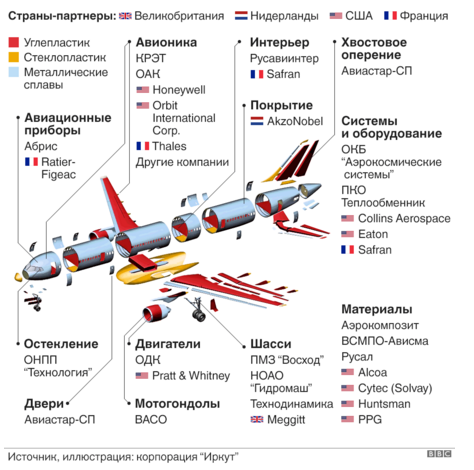
Source: https://aviation21.ru/
To master the operation of the new aircraft, it will be necessary to attract an additional 3,500 pilots. Aeroflot’s development strategy is synchronised with the program for the development of the transport industry until 2030, the head of Aeroflot has noted.
“The Aeroflot fleet now has about the same number of aircraft as it ordered. These are mostly foreign planes. However, every 10 to 15 years, Aeroflot-class airlines completely update their fleet. Therefore, Aeroflot has outlined its needs: over the next decade, to change its foreign fleet to a domestic one. This is if we do not talk about the growth of air traffic volumes, which will require expanding the fleet,” says the head of Avia.ru, https://www.aviaru.net/ Roman Gusarov.
At the same time, civil aviation is quite capable of increasing production volumes not only in order to satisfy the record order of Aeroflot, but also orders from other airlines, Gusarov believes. We are talking about a general order for the creation of 500 domestic airliners; that is, the remaining carriers will have 159 new domestic airliners.
The program for the development of the air transport industry until 2030 worth more than 770 billion rubles, which was approved by the Russian government in the summer, is supposed to deliver as many as 1,036 new domestic aircraft by 2030, but it includes not only the three types of airliners ordered by Aeroflot, but also the Ilyushin series Il-96 and Il-114; the Ural Civil Aviation Plant’s TVRS-44 Ladoga and the L-410 Baikal.
According to the plan, only two SSJ New [Sukhoi Superjet SSJ100, re-engined by United Engine Corporation] will be produced in 2023, but from 2024 the annual production will be 20 aircraft per year until 2030.
The plant has reached such production volumes, so these are quite realistic indicators. As a result, 142 SSJ New regional aircraft will be produced in Russia in eight years (Aeroflot has ordered 72 of the aircraft).
As for the MC-21, the carriers will get their first planes in 2024. It is planned to assemble six of them this year. In 2025 – twice as many – 12 MC-21. And then every year the output grows: in 2026 – 22 MC-21, in 2027 – 36, in 2028 – 50, in 2029 – 72, in 2030 – 72. That is, the plan is to release 70 MC-21 per year. In just eight years, 270 such airliners will be produced according to the plan (Aeroflot has ordered 210 craft).
The Tupolev Tu-214 production plan shows that from 2025 10 such machines will be produced every year, and by 2030 the total production volume will be 70 units (Aeroflot’s order is 40 machines).
THE TUPOLEV TU-214
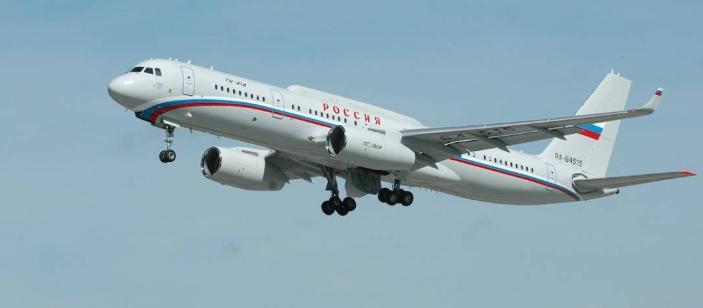
Source: https://www.ainonline.com/
Production volumes exceed the volume of Aeroflot orders. “As you can see, there is still a production reserve for other customers and airlines,” Gusarov points out.
This is a serious challenge for the Russian aviation industry. After all, we are talking about gradually entering the production of 100 civil aircraft per year. And if we take into account the rest of the small aircraft, then by 2029-2030 the total production of civil aircraft in Russia should grow to a record 186 aircraft per year. Russia has never produced so many civil aircraft in modern history. More than a hundred civil aircraft – this is already the level of the Soviet Union.
So, in the 2000s, no more than 20 aircraft were assembled in Russia. In the 2010s, there were some years when volumes grew, for example, in 2013, 35 civil aircraft were assembled; but it was not possible to keep up this level, and production fell again. Another example: in 2020, 11 SSJ-100 aircraft were built, in 2021 – 12 planes. The release rate has been one aircraft per month, but we need to double that.
“Even if not 500, but only 339 aircraft ordered by Aeroflot are produced, this will already be a great success for the domestic aviation industry,” says Gusarov. Understanding that there is a serious portfolio of orders for eight years ahead will allow the industry to see its prospects and invest in expanding production capacities without apprehension. Due to the transfer of the fleet to domestic equipment, Aeroflot is also getting a development strategy for the future so that no sanctions will be able to put pressure on the company,” the industry expert adds.
The MC-21 is a medium–haul narrow-body (single-aisle) aircraft in the most popular and largest-volume class in the world. It is the domestic competitor of Boeing and Airbus. That is why this plane was targeted with individual sanctions. At first, the West banned the supply of composite materials necessary for the production of the unique ‘black wing’. Russia has solved this problem by transferring to its own composite materials. Therefore, the West deprived the project of American engines. But even here the project of creating Russia’s own PD-14 engine has wiped its nose on the sanctions.
THE PD-14 AIRCRAFT ENGINE, REPLACING PRATT & WHITNEY
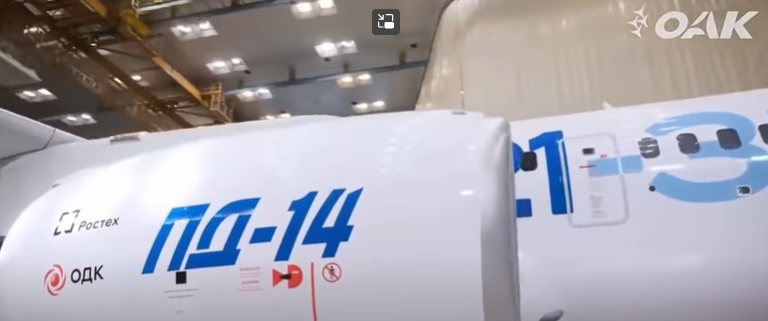
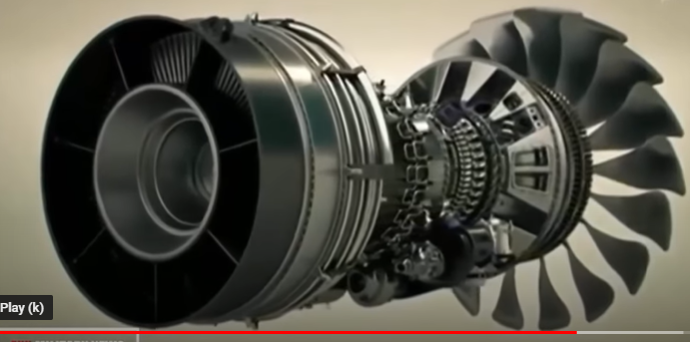
Source: https://www.youtube.com
“There are about 180 seats in the MC-21, this is the most popular variant. You can fly on this plane both in Russia and abroad without restrictions. Except for those countries that simply do not want to see Russian airlines. For the Sukhoi Superjet, it’s exactly the same situation. You can safely fly it anywhere. But this is a different class of aircraft – it is a short–haul aircraft with about half the number of passengers,” says Gusarov.
The SSJ-100 is a regional aircraft for transporting passengers on less distant routes, where passenger traffic is more modest. In general, this is a niche product, and its demand in Russia has been low all these years precisely because long-haul transportation abroad has been developing. However, now Russia is betting on the development of interregional, regional and local aviation within our vast country. And this is also an important part of the ‘systemic re-equipment’ of the aviation industry.
“If we look at the Soviet aviation structure, where Aeroflot was the largest airline in the world, then the Tu-154 was the most numerous aircraft in operation, and it was supported by the half-sized Tu-134. Now it turns out we shall precisely the same configuration. The Superjet-100 is half the size of the MC-21, and they will work perfectly in tandem, complementing each other. On regional routes, planes for 200 passengers are often redundant, they are under-loaded, and it is more profitable to use a half-sized airliner like the SSJ-100, or even turboprop-class aircraft like the Ilyushin Il-114, the serial production of which is also being prepared. But, of course, not on all the routes where the MC-21 flies, will the Sukhoi Superjet be able to fly because it has a shorter range,” says the head of avia.ru.
Aeroflot’s order portfolio includes 40 Tu-214 aircraft. However, this aircraft is in a quite intermediate stage. “This plane also has no restrictions for flights and can fly around the world. But it is unlikely to become mass-produced. This is an aircraft with outdated technologies, and in a number of characteristics it is inferior to Western analogues and the MC-21. But it is needed as a support for the industry for a certain time, while the serial production of the MC-21 will unfold. Our civil aviation needs only about 700 MC-21 mainline aircraft. But by 2030, we will be able to replace only half, at best, two–thirds of the fleet of medium–haul aircraft, and not completely,” says Gusarov. In other words, the Tu-214 is needed to close the gap for a while due to the shortage of MC-21 for all airlines as a replacement for the foreign-sanctioned equipment. However, gradually the carriers will hand over the Tu-214 to the state aviation, to special services, and they themselves will switch to the more economical and modern MC-21.”


